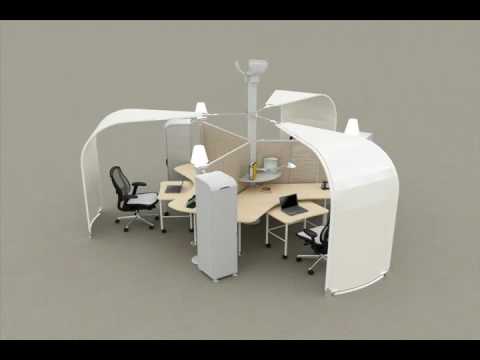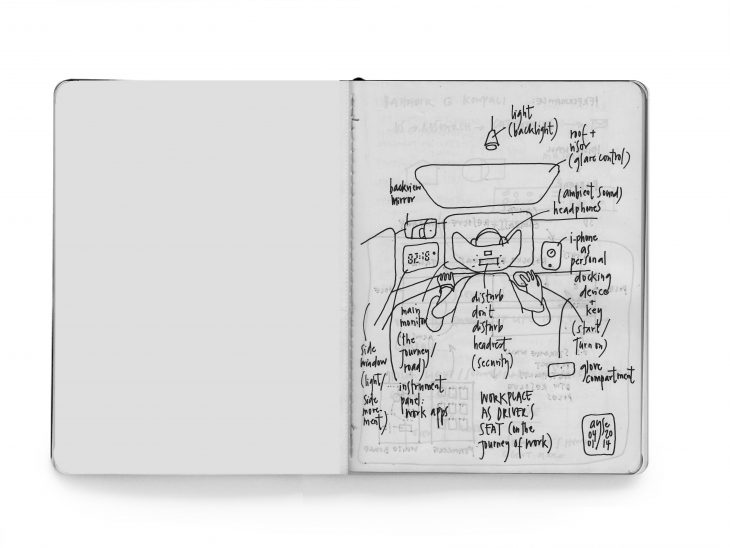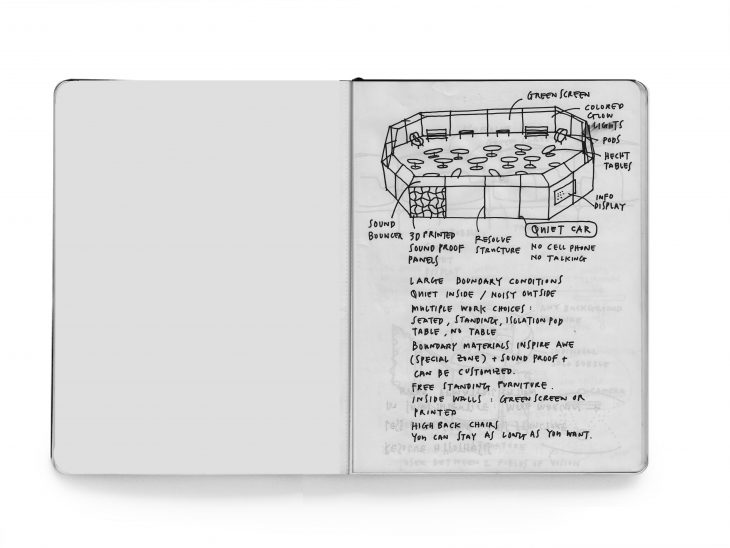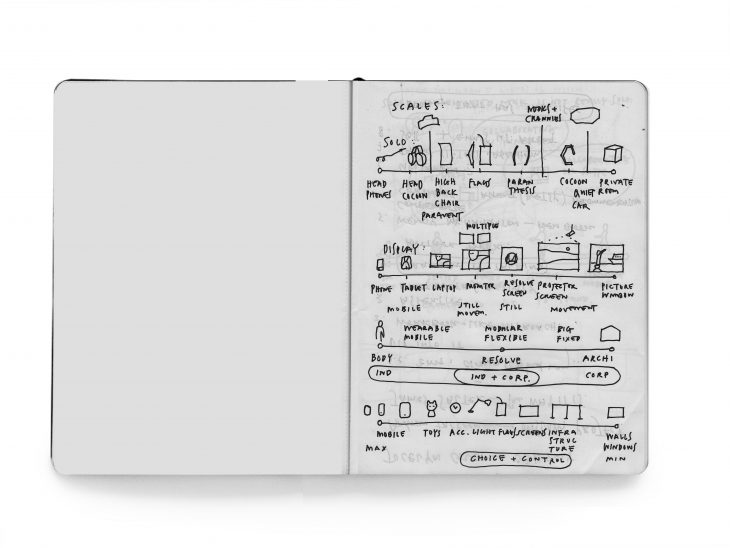WDM’s Elise Shapiro recently interviewed Ayse Birsel to learn more about the development of Herman Miller’s Overlay and her overall design philosophy.

One of the most photographed, instagrammed and shared images from this past NeoCon event was a vignette from Herman Miller’s new Overlay product line. We followed up with designer Ayse Birsel to find out more about the evolution of the product and her design practice in practice with Bibi Seck: Birsel + Seck.
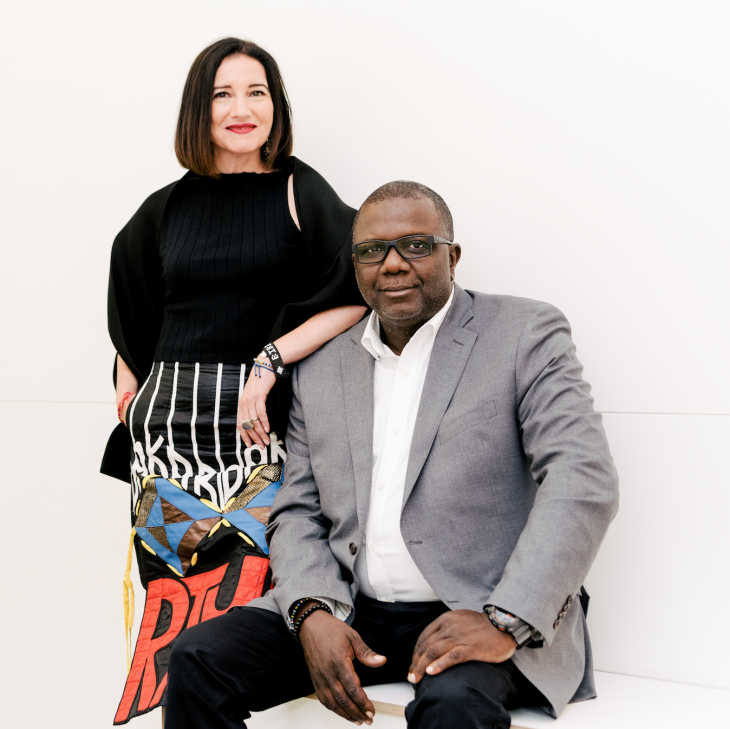
Having benefited from a process-oriented design education myself, I immediately tuned into the tagline on Ayse’s email signature and tagline on the Birsel + Seck website: “Design the Life You Love!” Our conversation was not so much about the specific product, but more about how it came to be as part of her long relationship with Herman Miller. We all know that evolutionary products do not just drop out of the sky, fully formed and executed. Design assignments are not only about creativity and creating something new, but more about solving a problem. In this case the problem is the on-going issues with working in open environments.
Where did the Overlay project start?
Twenty years ago, when we first started working with Herman Miller, Don Goeman told us that “our role as designers is to be the provocateurs – there is a mutual trust that is inherent in the relationship between the designer and manufacturer.” This is in direct alignment with the original vision of Herman Miller founder D.J. De Pree as the company engaged with visionary designers early on, such as Charles and Ray Eames and George Nelson. This is an integral part of Herman Miller’s DNA – to seek out the original and push the envelope.
Over time, things evolve and as the work environment changes, the furniture solutions need to change as well. Recognizing the need to adapt product offerings to meet the needs of workers in an open environment, and a company’s need to provide space to enable productivity, the discussion began over four years ago. It’s now more about solving the complex problems that give the “open office” such a bad rap, not just creating something new for the sake of making a new product introduction. The mandate gave us the freedom to be creative and to think both inside and outside the box.
How do you even begin?
In a nutshell, it’s all about the process. You need to analyze the problem. We have a very clearly articulated process we call Deconstruction: Reconstruction. This methodology allows us to examine all the moving parts and pieces of an issue, analyze the components, and develop solutions to meet the needs and desired outcome requested by clients. In this case it was meeting the need to provide alternate solutions to support work in the open office without resorting back to the enclosed, cellular structure provided by enclosed offices and vast seas of cubicles.
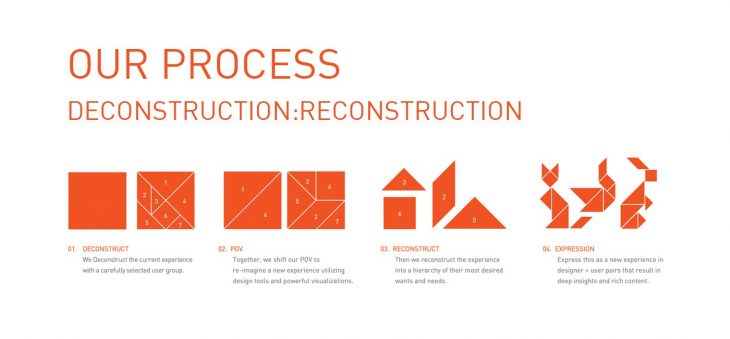
Once you define the problem how do you go about solving it?
Let’s go back in time for a moment. Our initial engagement with Herman Miller began with the Resolve system. It was introduced in response to the need for open systems that fostered collaboration balanced with a sense of enclosure and privacy. The product was also based on a 120 degree angle as opposed to the more rigid 90 degree systems that are most prevalent. There is a direct relationship to the design criteria for both Resolve and Overlay even though they are separated by almost twenty years of workplace evolution!
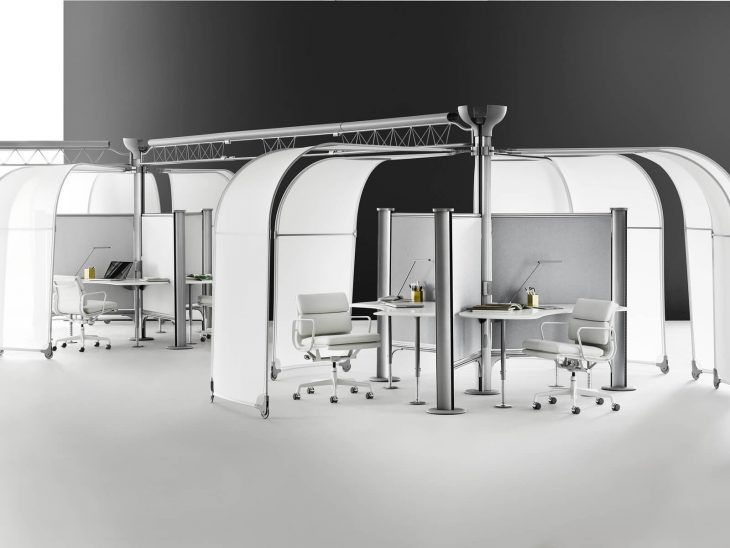
The key connection is that with increased technology options you can work anywhere. People also like to come to the office to be part of a community, to learn from each other. There is a desire to have individual yet connected spaces, but people do not like to sit in a box. We find that there is the concept of being in a village and being connected to your team. In those instances, there is opportunity for social interactions and learning moments to happen organically. Work is inherently communal, but there are some conditions when privacy and isolation, whether real or perceived, may be desired. The challenge for furniture design is to provide options to create spaces on an intimate and more human-scale, places that provide visual resting points and eliminate distraction.
Overlay is a product that builds on that premise. People like a sense of enclosure. The challenge as designers was about creating a place that is open yet closed, clean but creatively messy – resolving (no pun intended) these opposites – that’s where the innovation lies!
So, how did your process enable you to get from Resolve to Overlay?
This is where the Deconstruction comes into the process. Taking apart the issue and examining the components to help build new scenarios where the Reconstruction can occur. Considering the concept that a picture is worth a thousand words, the process includes thinking through the issues with graphic notations, examining the problem, and brainstorming possible solutions. It can be a holistic and organic process that touches on all aspects of analyzing the problem to come up with possible pathways to designing a solution. My main tool is a sketchbook for mapping out ideas.
- We had to identify and investigate the problem.
- Open offices have become almost too open. We know there is a need for space for heads down, creative or reflective work. The question is, how can we accommodate these activities? Herman Miller gave a mandate – as the designer of Resolve, how can you you bring current observations on solo work into the realm of the open environments people are creating. Help us think about what people need for solo work.
- What’s interesting about open offices is that there’s a backlash – two key objections to more open spaces are disruption to employee field of vision and concentration.
- Also interesting to us – in deconstructing the problem, visual noise is more distracting than acoustic noise. How do you respond to that? The other key piece is through our work, the design became focused on how users think about design.
- Most manufacturers think about product while users think about their life. I see my role as more about designing somebody’s life. That connects Herman Miller’s philosophy of being user-centric and our practice which emphasizes human-centric design.
- You must keep in mind that there is not one user – systems need to work for multiple users with a myriad of personality types and quirks.
- Individual users, managers, corporations, architects, and designers who use the product: In a way, when you think about this, our perspective when you deconstruct is what do the individuals need?
- We visited different office environments, from “fab labs” to start ups, to very established places like GE, Google, and Microsoft and talked to people. People love to work on planes, trains, and cafes. All these environments. Alone yet together.
Our observation also included that there were other places where we saw similar environments to the workplace – where people were working, such as libraries, coffee shops, airports, and parks. We started deconstruction by examining the common elements of these spaces. The reconstruction was that we saw that these places created an “alone together” environment. This allowed us to come up with a new kind of acoustic criteria – what people need and demand not to be completely isolated, but they want to have some background noise with some element of privacy. There is an ambient sound envelope – you can’t understand individual conversations but the buzz, it’s not distracting. We also needed to consider a way to manage the visual distractions and create design elements with boundary qualities – backdrops that offer visual relief for your eyes.
And the analysis showed…?
The 18 years since we first conceived Resolve has changed the work landscape (as previously noted) due to the rapid advances in technology allowing people to work anywhere – the untethering of people to their desks.
The design intent for Resolve was to create a contrast to cubicles. It was a system about connecting people where they have their own space, but it was within the larger village or neighborhood enabling teams to work together. “Your space” and “my space” is juxtaposed. However, it is still a cellular product.
We also had to consider the materiality and construction of whatever our new product would become. Resolve was innovative in that it was economical in weight and scale compared to more traditional systems furniture. There were fewer moving parts and pieces needed to construct a workstation. As we started to think about what would become of Overlay, we considered the type of materials we wanted to use, with an emphasis on choosing materials with an increased sustainability profile and simplicity of construction.
Conceptually we incorporated the desired feature of flexibility and choice that is informing so many contemporary work places. What if we designed our product to be like a theater set to support performance at work? We decided that the product needed to be simple to move, change, carry and adapt to different situations. Like Resolve, the question was how can we make more with less pieces. The solution yielded a product that can be configured easily by the users in multiple ways. Within two hours, two people can create a space for what they want to do next.
How did you get from concept to reality?
In the reconstruction phase we got into examining the emotion of solo work and the flow of creativity and contemplation. It was important to match those emotions to an architectural solution that allows people to share a flexible space.
We considered that in real life, work needs change daily, and that there could be a new team created, staff changes, or new project needs. We realized that we had to figure out a way to meet the considerations involved in changing up work environments and the time and materials required to effect those changes. It takes seconds to download an app or update your phone with current technology. What is the equivalent in architecture that is seamlessly fast and agile? A phone and office space are not the same, yet expectations to facilitate change are just as high. We also thought about this from the facility manager perspective where there is a need to move people around with minimal disruption.
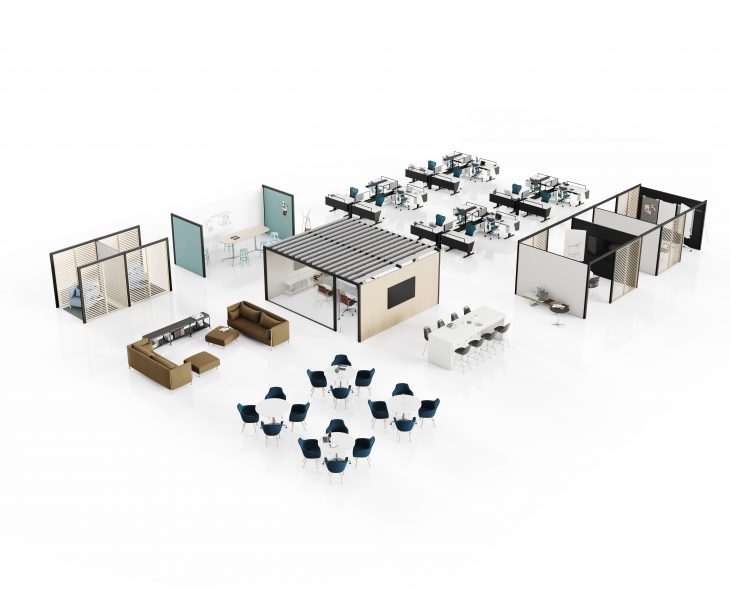
This defined our criteria: make more with less, create a small kit of parts, must be easy to move. Herman Miller weighed in with the two-hour, two people benchmark that led us to the free-standing architectural framework and solution. The elements had to be light enough and easy to move around, yet needed to feel substantial when you are sitting in it. We knew at that point we needed a vertical element to create the visual boundary and sense of enclosure. This would support the need to have writable elements, hang project boards or mount technology. Drawing and diagramming are part of our work tools.
Our new idea has roots in an old tradition. Overlay conceptually is aligned with the inspiration derived from the Japanese shoji and folding screens. Screens are lightweight, and you can create a wall or sense of enclosure with this simple yet functional design elements. Originally designed as protection against the wind, in the traditional sense, they serve to divide large open spaces into more intimate and private spaces. The adage, “everything old is new again” illustrates that a design solution may existing in another realm. In this case, traditional Japanese architecture has been implanted into an office systems furniture solution.
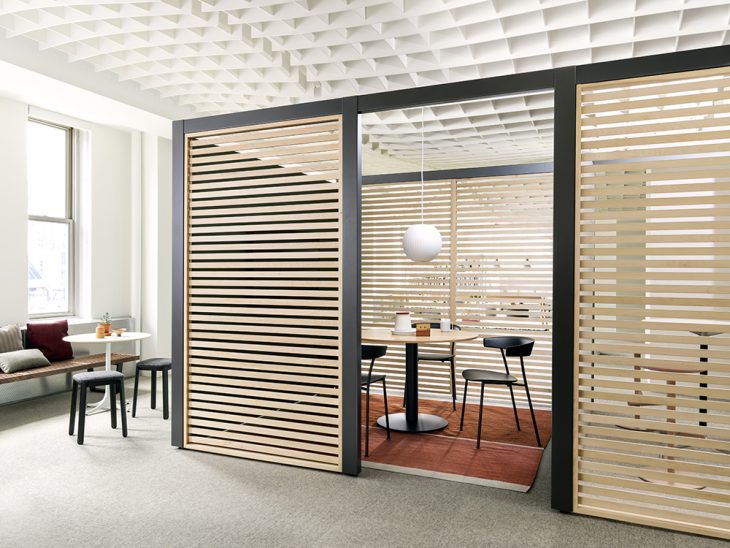
Final Thoughts
It’s always fun and interesting to find out how products come to market. We know there is a life-cycle to the evolution of new product offerings. In the moment of seeing the final product presented, we can lose sight of what it takes to conceptualize, design, fabricate, and introduce it. In our rapidly changing and shrinking world, it can be refreshing to stop and think about how and why things change. All the market analysis in the world cannot predict what will happen. Ten years ago, who would have predicted the impact WeWork would have on how office space is procured and used? Twenty years ago, who would have predicted that we could run a business from the phone in our pocket or purse?
The roots of open offices lie in the original research and product development by Robert Probst and Action Office at Herman Miller. The ongoing research by Herman Miller and their colleagues in the contract furniture realm continue to push the envelope to meet the needs of today’s workforce and anticipate and meet the needs dictated by the advances in technology that drive so much of business today.
By sharing the story of how Overlay came to be and the designer’s perspective on that journey reinforces that at the end of the day it is about people and meeting the very human needs that are required to be met in all the spaces we occupy. This is the part of the story illustrates how the product solves the design problem in a way that is unique in the market.

